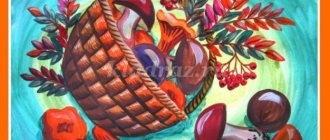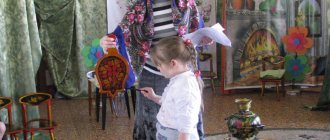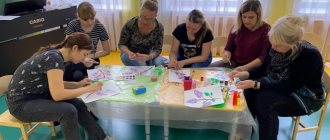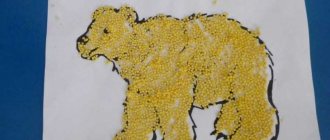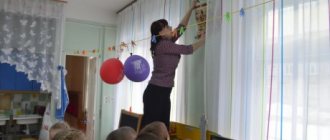Summary of GCD on application for children of the preparatory group. "Appliances"
Summary of GCD on application for children of the preparatory group. "Appliances". Training tasks:
consolidate the ability to cut out objects in round, oval, triangular shapes and paste images of a familiar object, create a simple composition, measure images with the size of the sheet, beautifully arrange the image on the sheet;
Developmental tasks:
develop imagination, creativity, fine motor skills;
Educational objectives:
to cultivate aesthetic taste when selecting paper of matching colors to compose an image.
Material:
colored paper, a sheet of white paper, scissors, glue, oilcloth, napkin.
Equipment:
letter from Cinderella, illustrations of floor lamps.
Progress of the lesson:
Guys!
I came to work today and there’s a letter on my desk, let’s see who it’s from? From Cinderella, what is written there? (letter) “Hello guys. There was a real disaster in my castle. All household appliances and all the lamps in the house burned out. I’m getting ready to go to the ball, but before that I need to do all the housework. How can I do everything if the house is so dark? Help me please". Educator: Well, guys, let's help Cinderella? (yes) Educator: What are “household appliances”? (what is used to make homework easier) Educator: Where can you buy “household appliances”? (in a store, at the market) Educator: That's right, in a household appliances store. Well, we’re going to the land of “Household Appliances,” but to get there, you’ll have to answer questions about what these electrical appliances are for. Ball game: “Continue the sentence”
A vacuum cleaner is needed to... Meat grinder... Hairdryer... Refrigerator... Mixer... Washing machine... Floor lamp...
Main part:
Educator: I suggest you make “household appliances” yourself, a floor lamp and give it to Cinderella.
To do this, you have blanks of colored paper on your plate. What geometric figure do they resemble? (rectangle) Educator: You need to choose what shape your floor lamp will be: round, triangular, oval, flower-shaped. When you cut out all the parts, lay them out on a sheet of paper and look at where you will glue them. Only then spread the parts on the oilcloth, glue them, remove excess glue with a napkin. Don’t forget to put the scissors in a glass (repeat the rules for working with scissors), and the trimmings in a plate. Completing of the work. Result:
Guys, look how wonderful our floor lamps turned out. Now let's put them in an envelope and send them to Cinderella.
What are the benefits of template applications for development?
Paper applications are a creative process through which children learn about the world around them and acquire many skills. In addition to the development of fine motor skills of the hands, this includes coordination of movements, the study of colors and their combinations, the concept of composition, familiarity with various materials and textures, the development of observation, imagination and fantasy.
Working on an application in a team promotes organization, restraint, and accuracy. It is also necessary to note the development of spatial imagination: when doing appliqué, children create a whole from several components and, conversely, learn to divide the whole into parts.
Scientists have proven that in the cerebral cortex, the center responsible for fine motor skills is located next to the speech center and contributes to the development of speech skills.
Fire truck applique
This craft is so simple that even small children can do it. And if the child is a little older, he can even help cut out and trace the template. Necessary materials for application in the senior group of fire trucks:
- Drawing.
- Cardboard.
- Scissors.
- Pen or pencil.
- Glue.
As in the previous version, it is recommended to print the template on cardboard. You can also use regular printing paper if your printer won't accept thick paper, but cardstock is an economical and convenient option that can be reused many times in the future.
Once the pattern is printed, the child simply cuts out the shapes using scissors.
Once all the shapes are cut out, you can start choosing the background color. Most often it is blue, as it resembles a clear and bright sky. On this basis, the red details will look even more impressive.
First of all, the children glue the body onto the base. Then two black outer tires and a center one. Two windows are added, a staircase and finally a yellow light at the top.
You can add a road under the fire truck or clouds in the sky to complete the scene to your liking. The fire truck applique is an excellent reason to tell your child about this profession while working.
Police car applique
It's a fun activity to make things out of paper with your own hands. Parents need to: download and print the template, cut it out, fold it along the lines, and glue it.
You can also paint the car yourself by pre-printing the drawing in black and white. The car will be unique. The main point of assembling such a machine using origami and appliqué techniques is the possibility of play.
If made from thick cardboard, the vehicle will be stable and strong.
Such a machine can even be made from an old cardboard shoe box or equipment. Any ideas:
- Cut several holes for windows.
- Next, cut off the parts for the doors; this must be done so that they can open.
- Afterwards the structure is simply covered with colored paper.
This version of the craft can become a full-fledged toy or work for a competition. This work is similar in technique to fire truck appliqué.
Car applique
This option is good for all ages. To inspire your child, you can take a short walk around the city where he can watch the traffic. Next, it is recommended to study the master class:
- Parents often develop creativity through the “observe and play” technique.
- Children see the world differently, and with the help of art they can show it to adults (by the way, appliqué often helps to identify experiences or concerns; psychologists use this method).
- To work you will need colored paper, safety scissors, glue stick, rulers, compass.
- Using a compass, wheels and the sun are drawn on black paper.
- Next, using a ruler, the main elements are formed - trunk, windows, doors, body, etc.
- It is necessary to make a background - it is done using colored paper.
- Clouds or gas emissions are made using the torn technique - colored material is carefully torn, the child can create any interesting shape.
- Next, all the details are cut out and folded onto the background, after which they are glued.
Such work can even be submitted to a competition in kindergarten.
Winter themed applications
To create winter and, in particular, New Year's applications, any of the described techniques is used, depending on the age of the children.
The most common type of winter applique is snowflakes - this is a subtype of silhouette type applique. It is recommended to fold the sheet correctly, trim the edge and sharp corner, and make cuts on plain paper first - this is how the skill is developed.
In addition, pendants made of such snowflakes decorate the room. Thin, airy snowflakes can be glued to windows and other surfaces.
For small children, it is better to prepare templates (circles with an outline) and make a broken snowflake from pieces. For flat, voluminous, multi-layer snowflakes, you need to prepare patterns for cutting.
To make a traditional Christmas tree, kids use triangles from green paper, a snowman is made from white circles, and a teacher or parent helps add details to the applique.
Older children can be asked to make a Christmas tree from strips of paper or create a picture of a winter forest using templates using small pieces of paper or cotton wool.
A Christmas tree made of paper balls looks bright and voluminous. For this purpose, a template and elements are made from crepe paper. The main color is dark green; multi-colored balls are made for the garland.
After applying glue to the template, it is recommended to first position the garland, then fill the outline with “needles” and complete the applique with a star and base.
An interesting applique depicting winter accessories allows children to show their creative imagination.
The hat and mittens can be decorated with any ornament, animal figures, winter pictures, beads or rhinestones.
Cotton wool is used to imitate fur.
Using a disposable plate, you can make a polar bear mask craft. Holes are cut out in the plate for eyes, the surface is covered with pieces of paper, and a disposable cup is used for the nose.
Senior preschoolers and elementary school students are able, under the guidance of adults, to create complex winter landscapes using mixed techniques.
Fabric machine applique
This part of the master class is suitable for mothers who want to decorate towels or bed linen for their babies. Stripes are often used for identification in kindergartens; teachers may ask them to buy them or make them themselves.
The technique is quite simple, especially if you have a sewing machine at hand:
- First you need to choose bed linen or clothing on which embroidery will be done.
- Next, you need to download and print a special machine template for the applique. It will make the work much easier.
- After this, the threads are selected.
- The sewing machine is refueled and you can start working.
- Each detail is carefully stitched.
You can also do this work on a separate piece of fabric to use the machine as a patch. If the work is done for a kindergarten or camp, it is appropriate to add the name or the first letters of the initials. This can also be done using standard stitches.
If you don’t have a machine at hand, you can do the appliqué by hand, which will take more time.
Applique is a great way to develop motor skills and creative skills in a child. Working together brings adults and children closer together, which will have a positive impact on relationships in the future.
On the topic: methodological developments, presentations and notes
senior group applique
cheerful snowman applique.
Lesson summary application.Senior group
Application. Senior group
Snowmen in hats and scarves. Applique. Senior group.
Goal: Learn to create an expressive image of a snowman, as accurately as possible, conveying the shape and proportional relationship of its parts. Tasks: · Induce intelligence.
Summary of a game lesson on the formation of elementary mathematical concepts and applications. (senior group) Topic: “Seven-flowered flower”
Summary of a game lesson on the formation of elementary mathematical concepts and applications. (senior group) Topic: “Seven-flowered flower.”
Summary of direct educational activities on the application. (senior group)
Summary of direct educational activities on the application. (senior group) On the theme: “Autumn Forest” Volumetric applique. Teamwork. Goal: Formation of skills de.
Source

